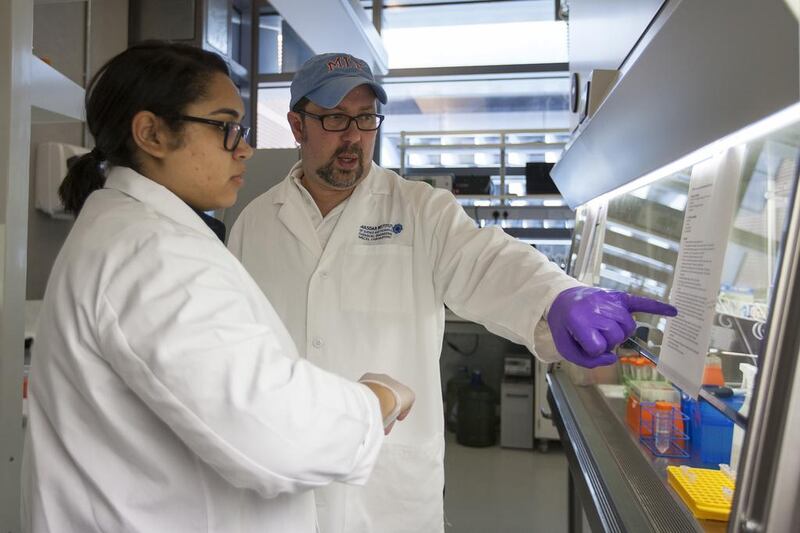Sandstorms not only disrupt traffic but also our health. Scientists report microorganisms carried from thousands of kilometres away bear viruses and diseases not native to our region, which then attack our immune systems.
Scientists in the UAE are discovering that sandstorms like the one we saw last week can lead to more than just poor visibility, bad traffic and tight chests.
A team from Masdar Institute of Science and Technology is cataloguing naturally occurring microorganisms in an effort to better identify alien species that hitch rides on tiny dust particles. They can travel from as far away as North Africa and Mongolia, bringing diseases with them.
The team, led by Dr Hector Hernandez, has spent more than 18 months collecting and analysing samples to build a database of local species that will allow them to identify when “alien” microorganisms enter the air.
It could also help them to identify alien microorganisms that pose a threat to native marine life.
“It involved going out and getting samples over time because the weather here changes so drastically between summer and winter, and also drastically between the dunes and the mountains in the south,” says Dr Hernandez, an assistant professor of chemical engineering.
“We’ve been trying to collect these samples and build a library of what’s here. If you build this catalogue you can tell when newcomers come in because they’re different to what you know is here. There are early detection systems so when you test the environment, you can tell if there is a new organism. It’s particularly important if you know it’s one that causes disease.”
The early detection systems that could be used when the catalogue is complete are quantitative as well as qualitative, so when the numbers of microorganisms reach a threshold, public health officials could issue alerts and take better preventive measures.
“When you think about a health event that is a challenge to society you must think about the timing of events. We have flus in the winter and, usually in late January or February, we have dust storms.
“This year has been particularly bad with the flu so a large part of the population was already under health stress; their body was trying to fight off the flu virus, so when the microbes invaded, their body was already under stress.
“Previously we didn’t associate the dust storms with lung disease. But you go to the emergency rooms at these times, patients are there. They think they have chest irritation but this is a physical, serious, treatable disease that needs antibiotics. We’ve only just correlated this.”
Last week saw some of the worst dust storms in recent years, with visibility reportedly down to less than 100 metres in some parts of the country.
Because dust storms happen all year round but respiratory diseases only show up in winter, the link between the two was only recently discovered, says Dr Hernandez.
That disease-causing microorganisms travel in dust storms is relatively new to scientific knowledge.
Up until recently, or at least within the past 10 years, the prevailing opinion was that the effect of the small particles in dust storms was limited to suppressing the immune system and aggravating existing respiratory conditions.
A 2011 study released by the Centre for Naval Warfare Studies, US Naval War College, Rhode Island, found that dust particles tested in Kuwait and Iraq carried very high levels of metals and microbial matter.
More than 147 different types of bacteria were isolated, including some that showed antibiotic resistance.
Those found in the samples included Staphylococcus aureus, the resistant form of which is known as MRSA; malaria-causing Neisseria meningitidis; and Acinetobacter baumannii, a superbug linked to severely injured soldiers and which targets the seriously ill.
This showed they travelled long distances in the air and were not just transferred from human to human, as previously thought. In Abu Dhabi emirate, there are 20 air monitoring stations dotted across the cities and desert.
Monitored by the Environment Agency Abu Dhabi, they collect data on the levels of particulate matter in the air, which are known to be damaging to human health.
The largest concern is the tiny particles of matter that travel deep into the lungs. They are identified as PM10 and PM2.5, which refers to diameters in micrometres.
According to 1999 rules, PM10 levels in the country should not exceed 150 microgrammes per cubic metre in 24 hours. The global guideline from the World Health Organisation is a third of this figure. WHO says this is to encourage “a gradual shift from high to lower concentrations”. Some countries issue public health warnings about air quality if the levels are expected to rise above recommended guidelines.
Up to 70 per cent of the small particulate matter floating in the air comes from the natural desert environment, and the remainder is caused by humans.
“There’s several things that make you sick from the sand coming in,” says Dr Hernandez.
“One of the reasons is the size of the particles. The size of them causes asthma because they go deep down inside the lungs; the sand is ground very finely.
“There’s not much you can do about this apart from to not go outside. Masks help, and you see the workers out there with their headscarves. They moisten their scarves so they act like filters.”
The only solutions to avoiding problems caused by particulate matter in the air is to not go outside and to use Hepa (high-efficiency particulate arrest) filters in the home.
“The bigger problem that is not being addressed and not being looked at is the microorganisms that travel in the clouds and in the clouds of dust. They attach to the sand particles and when you breath them in, they land in this beautiful environment,” Dr Hernandez says.
“There is an even temperature, fluid and food, so they grow. The growing is when the respiratory diseases arise. They’re not like flus that are caused by viruses. So it’s not like you have the flu, you actually have a respiratory disease.”
The most recent figures available from the Health Authority Abu Dhabi, released in November with data for 2013, showed that respiratory infections and diseases were the second and fifth most common diagnoses in the emirate.
They accounted for 11.1 and 6.7 per cent of diagnoses respectively. There is no individual breakdown available of what the causing agents were.
A catalogue of existing, local microorganisms would assist the health authority in identifying particular respiratory diseases that rise rapidly during dust storms when particles are coming in from elsewhere.
In terms of global research, there are few scientific papers on the topic, partly because of the logistics involved in studying the spread of microorganisms across countries and continents.
But even basic knowledge of weather patterns gives scientists and health officials some indicators of what they should be looking out for.
“We have storms that start in Syria and Saudi Arabia, and they will be here in half a day. It takes a day for some of them that start in North Africa to come over here. Then you have Mongolia that comes down when the wind goes the other way.
“We didn’t understand how it happened. But now we are starting to develop this picture of how they live and how they attach to the particle, and how far they can travel in a very short amount of time.”
In a dust storm the concentration of dust particles and microorganisms increase significantly, and this can be harmful for two reasons.
“Your body can fight off a hundred, but a thousand or a million of them becomes an issue,” says Dr Hernandez.
Immune systems also develop certain defences according to what the body has been exposed to. It would not be able to resist new, previously unfamiliar microorganisms. He says: “That’s how they take hold.”
Dr Hernandez and his team use a sequencing method to identify local organisms.
“We now have ability to analyse a million, a hundred million of them at the same time.
“Traditionally we had to grow them in a lab, isolate them and study them. Now we have a new way of doing that.
“I can take a sample and extract the DNA from that sample and I can look for a marker, a gene, and align the sequence in those genes because it’s DNA. Then I can make a map of how related they are to each other, and that gives me an idea of what’s there.”
munderwood@thenational.ae





